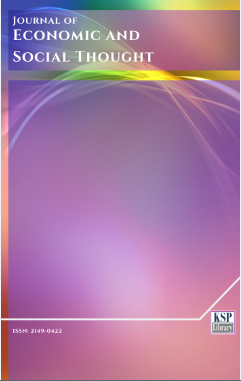Engendering the Welfare State: How Fa(i)r Are the Scandinavian Welfare States
Abstract
Abstract. Welfare state or state social provision is perceived as interventions by the state in civil society to alter social forces, including male dominance. A gender-neutral welfare state is not possible on the contrary gendered assumptions constitute the backbone of the welfare state regimes. Feminists have contributed to the literature immensely and categorization of welfare states from a gender-aware perspective has become a rich field that answers “what type of social security system with which assumptions, priorities and with what type of society provision?” The paper discusses the reform agenda and feminist welfare state utopia, “the real utopia”, in which both men and women can perform as autonomous, free individuals in the public and private spheres. In this regard, the Scandinavian states are far ahead compared to the rest of the world in terms of reforms undertaken, yet the question remains: Is the Scandinavian case a blueprint for “the Real Utopia”? The paper aims to answer this question primarily by presenting feminist economists concerns on welfare state regulations, the suggested reform agenda, secondly by analyzing and evaluating Scandinavian model in a historical and conceptual context.
Keywords. Welfare state, Feminist economics, Scandinavian, Social policy, Parental leave.
JEL. B54, H53, H55, I38, J29.
Keywords
References
Addati, L., Cassirer, N., & Gilchrist, K. (2014). Maternity and Paternity at Work: Law and Practice Across the World. International Labour Office.
Agarwal, B. (1997). Bargaining and gender relations: Within and beyond the household, Feminist Economics, 3(1), 1-51. doi. 10.1080/135457097338799
Bergmann, B. (1995). Becker’s theory of the family: Preposterous conclusions, Feminist Economics, 1(1), 141-150. doi. 10.1080/714042218
Bergman, H., & Hobson, B. (2002). Compulsory fatherhood: the coding of fatherhood in the Swedish welfare state. in B. Hobson (Ed.), Making Men into Fathers: Men, Masculinities and the Social Politics of Fatherhood, (pp.92-124), Cambridge University Press.
Cagatay, N. (1998). Gender and Poverty. UNDP, Social Development and Poverty Elimination Division.
Chant, S. (2003). The ‘engendering’ of poverty analysis in developing regions: Progress since the United Nations decade for women, and priorities for the future. Gender Ins. Working Paper, No.11. [Retrieved from].
Christopher, K., England, P., Smeeding, T.M., & Phillips, K.R. (2002). The gender gap in poverty in modern nations: Single motherhood, the market and the state. Sociological Perspectives, 45(3), 219-242. doi. 10.1525/sop.2002.45.3.219
Ciccia, R., & Bleijenbergh, I. (2014). After the male breadwinner model? Childcare services and the division of labor in European countries. Social Politics: International Studies in Gender, State & Society, 21(1), 50-79. doi. 10.1093/sp/jxu002
Crompton, R. (1999). Restructuring Gender Relations and Employment: The Decline of the Male Breadwinner, Oxford: Oxford University Press.
Elson, D., & Cagatay, N. (2000). The social content of macroeconomic policies, World Development, 28(7), 1347-1364. doi. 10.1016/S0305-750X(00)00021-8
Elson, D. (1995). Gender awareness in modeling structural adjustment. World Development, 23(11), 1851-1868. doi. 10.1177/097152159400100201
Esping-Andersen, G. (1990). The Three Worlds of Welfare Capitalism, Princeton, NY: Princeton Univ. Press.
Esping-Andersen, G. (2002). A child-centred social investment strategy. in G. Esping-Andersen, Why We Need a New Welfare State, (pp.26-67), Oxford Index. doi. 10.1093/0199256438.001.0001
Folbre, N. (2001). The Invisible Heart: Economics and Family Values. New Press.
Folbre, N. (1986). Hearts and spades: Paradigms of household economics. World Development, 14(2), 245-255. doi. 10.1016/0305-750X(86)90056-2
Fraser, N. (1994). After the family wage: gender equity and the welfare state. Political Theory, 22(4), 591-618. doi. 10.1177/0090591794022004003
Fukuda-Parr, S. (1999). What does Feminization of poverty mean? Isn’t it lack of income?, Feminist Economics, 5(2), 99-103. doi. 10.1080/135457099337996
Gornick, J.C., & Jacobs, J.A. (1998). Gender, the welfare state, and public employment: A comparative study of seven industrialized countries. American Sociological Review, 63(5), 688-710. doi. 10.2307/2657334
Gornick, J.C., & Meyers, M.K. (2008). Creating gender egalitarian societies: An agenda for reform. Politics & Society, 36(3), 313-349. doi. 10.1177/0032329208320562
Hakim, C. (1995). Five feminist myths about women's employment. British Journal of Sociology, 46(3), 429-455.
Hernes, H. (1988). Scandinavian citizenship, Acta Sociologica, 31(3), 199-215. doi. 10.1177/000169938803100301
Hook, J.L. (2006). Care in context: Men's unpaid work in 20 countries, 1965–2003. American Sociological Review, 71(4), 639-660. doi. 10.1177/000312240607100406
Lewis, J., & Giullari, S (2005) The adult worker model family, gender equality and care: The search for new policy principles and the possibilities and problems of a capabilities approach, Economy and Society, 34(1), 76‐104. doi. 10.1080/0308514042000329342
Lister, R. (2009). A Nordic nirvana? Gender, citizenship, and social justice in the Nordic welfare states. Social Politics, 16(2), 242-278. doi. 10.1093/sp/jxp007
MacDonald, M. (1998). Gender and social security policy: Pitfalls and possibilities. Feminist Economics, 4(1), 1-25. doi. 10.1080/135457098338536
Molyneux, M. (1985). Mobilization without emancipation? Women's interests, the state, and revolution in Nicaragua. Feminist Studies, 11(2), 227-254. doi. 10.2307/3177922
Mósesdóttir, L. (1995). The state and the egalitarian, ecclesiastical and liberal regimes of gender relations. British Journal of Sociology, 46(4), 623-642. doi. 10.2307/591575
Nelson, J. (1996). Feminism, Objectivity and Economics, London: Routledge.
Orloff, A. (1996). Gender in the welfare state. Annual Review of Sociology, 22, 51-78. doi. 10.1146/annurev.soc.22.1.51
Orloff, A.S. (2009). Gendering the comparative analysis of welfare states: An unfinished agenda, Sociological Theory, 27(3), 317-343. doi. 10.1111/j.1467-9558.2009.01350.x
Skjeie, H., & Siim, B. (2000). Scandinavian feminist debates on citizenship, International Political Science Review, 21(4), 345-360. doi. 10.1177/0192512100214002
Standing, G. (2004). Eight crises of social protection. In L. Beneria & S. Bisnath, (Eds.), Global Tensions: Challenges and Opportunities in the World Economy, (pp.111-133), Routledge.
UNICEF. (2016). [Retrieved from].
World Economic Forum. (2015). Global Gender Gap Report, Switzerland.
DOI: http://dx.doi.org/10.1453/jest.v4i1.1229
Refbacks
- There are currently no refbacks.
Journal of Economic and Social Thought - J. Econ. Soc. Thoug. - JEST - www.kspjournals.org
ISSN: 2149-0422
Editor: [email protected] Secretarial: [email protected] Istanbul - Turkey.
Copyright © KSP Library




